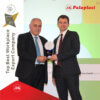
Eggplant – A Valuable Crop with High Demands
The eggplant (Solanum melongena L.) belongs to the Solanaceae family and is a unique plant that can be cultivated both outdoors and in greenhouses as an annual crop, depending on the climate of the region. Native to Asia, it is considered one of the most popular vegetables.
Its cultivation begins in seedbeds, using already developed seedlings. The recommended transplanting period is from May to June, depending on the microclimate. There are many varieties, selected based on fruit size and shape.
Cultivation
Sowing – Planting
Eggplants develop roots at intermediate depths, making them adaptable to various soil types. However, they thrive in medium to light-textured soils with good drainage and a pH between 5.5 and 7.3. They are sensitive to salt presence in both soil and irrigation water.
Planting is done in rows with spacing of 0.7–0.9m between rows and 0.5–0.6m between plants. Once plants reach 30 cm in height, they need staking. Plant density ranges from 1,600 to 2,500 plants per acre.
Eggplant seeds require at least 2 weeks to germinate under optimal conditions (20°C), and another 5 weeks for the seedlings to be ready for transplanting.
Growth
Eggplants are warm-season plants with high sunlight requirements. Optimal growth temperatures are 22–30°C during the day and 18–24°C at night. While they are drought and heat tolerant, they are sensitive to cold.
Cultivation Requirements
Fertilization
Eggplants have high nutrient requirements due to their productive nature. Maintaining high yields requires proper fertilization with macro- and micronutrients (nitrogen, potassium, phosphorus, calcium, magnesium, boron, etc.).
Special attention should be given to the nitrogen-to-potassium ratio, depending on the plant’s growth stage. Soil analysis is essential to accurately determine nutrient needs.
Plant Protection
Eggplants are susceptible to insect pests (mites, whiteflies, aphids, leafminers, thrips), nematodes, and fungal diseases such as Sclerotinia, Verticillium wilt, Fusarium wilt, Rhizoctonia, Alternaria, and Botrytis.
Timely and proper pest and disease control, guided by expert agronomists and appropriate crop protection products, is critical.
Irrigation
Water needs vary depending on plant growth stage, soil type, and weather. Water stress reduces fruit quality and color uniformity.
Drip Irrigation
The most efficient method is drip irrigation, which ensures precise water delivery and allows fertigation. Recommended emitters provide up to 4 l/h, with spacing between 0.3–0.5m. About 1,100–1,500 meters of drip lines are required per acre. Maximum required water flow can reach up to 20 m³/h.
Sprinkler Irrigation
This method uses large-radius sprinklers (“cannons”) mounted on irrigation reels. It requires powerful pumping units and is sensitive to wind conditions.
Eggplant cultivation demands knowledge, care, and the use of modern techniques—especially in irrigation. With the right equipment, such as that offered by Palaplast, efficiency, water savings, and high production quality are ensured. Our innovative solutions, with durable and reliable products, support every professional grower at every stage.
- Irrigation Pipes AGROPAL HDPE 80 and HYDROPAL PE 100
- Dripline Pipes (Paladrip , Paladrip-XL , Paladrip-Slim, Paladrip-FC)
- Dripline Tape (Paladrip Τape-SD, Paladrip Τape-DD)
- Dripline Fittings
- Drip Tape Fittings
- Filters
- Valves
- Compression
- Lock

